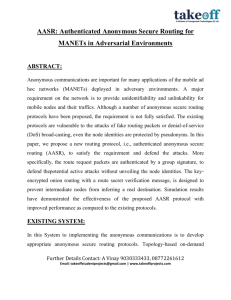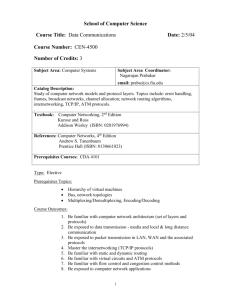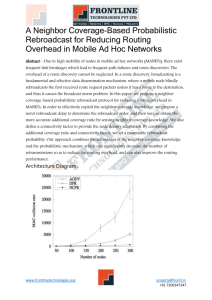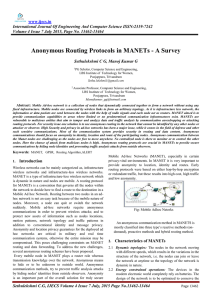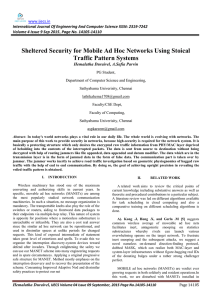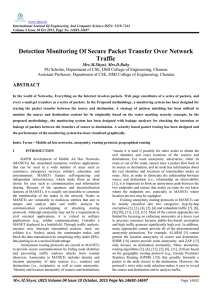ALERT An Anonymous Location-Based Efficient Routing Protocol in
advertisement
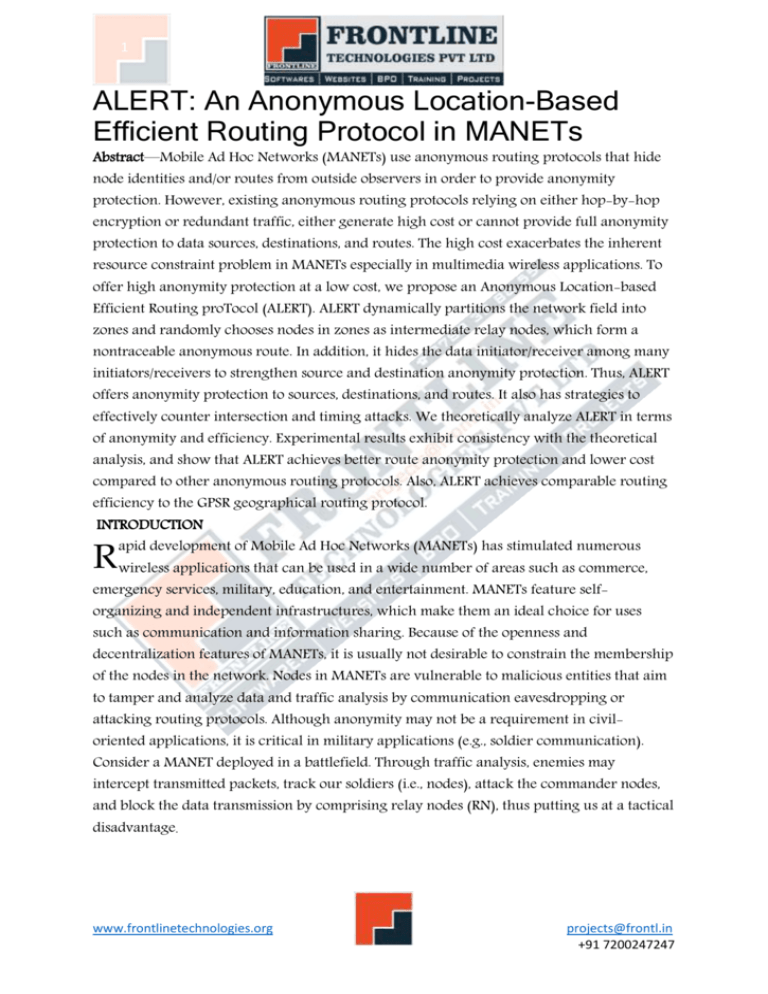
1 ALERT: An Anonymous Location-Based Efficient Routing Protocol in MANETs Abstract—Mobile Ad Hoc Networks (MANETs) use anonymous routing protocols that hide node identities and/or routes from outside observers in order to provide anonymity protection. However, existing anonymous routing protocols relying on either hop-by-hop encryption or redundant traffic, either generate high cost or cannot provide full anonymity protection to data sources, destinations, and routes. The high cost exacerbates the inherent resource constraint problem in MANETs especially in multimedia wireless applications. To offer high anonymity protection at a low cost, we propose an Anonymous Location-based Efficient Routing proTocol (ALERT). ALERT dynamically partitions the network field into zones and randomly chooses nodes in zones as intermediate relay nodes, which form a nontraceable anonymous route. In addition, it hides the data initiator/receiver among many initiators/receivers to strengthen source and destination anonymity protection. Thus, ALERT offers anonymity protection to sources, destinations, and routes. It also has strategies to effectively counter intersection and timing attacks. We theoretically analyze ALERT in terms of anonymity and efficiency. Experimental results exhibit consistency with the theoretical analysis, and show that ALERT achieves better route anonymity protection and lower cost compared to other anonymous routing protocols. Also, ALERT achieves comparable routing efficiency to the GPSR geographical routing protocol. INTRODUCTION apid development of Mobile Ad Hoc Networks (MANETs) has stimulated numerous Rwireless applications that can be used in a wide number of areas such as commerce, emergency services, military, education, and entertainment. MANETs feature self- organizing and independent infrastructures, which make them an ideal choice for uses such as communication and information sharing. Because of the openness and decentralization features of MANETs, it is usually not desirable to constrain the membership of the nodes in the network. Nodes in MANETs are vulnerable to malicious entities that aim to tamper and analyze data and traffic analysis by communication eavesdropping or attacking routing protocols. Although anonymity may not be a requirement in civil- oriented applications, it is critical in military applications (e.g., soldier communication). Consider a MANET deployed in a battlefield. Through traffic analysis, enemies may intercept transmitted packets, track our soldiers (i.e., nodes), attack the commander nodes, and block the data transmission by comprising relay nodes (RN), thus putting us at a tactical disadvantage. www.frontlinetechnologies.org projects@frontl.in +91 7200247247 2 Architecture Diagram: CONCLUSION Previous anonymous routing protocols, relying on either hop-by-hop encryption or redundant traffic, generate high cost. Also, some protocols are unable to provide complete source, destination, and route anonymity protection. ALERT is distinguished by its low cost and anonymity protection for sources, destinations, and routes. It uses dynamic hierarchical zone partitions and random relay node selections to make it difficult for an intruder to detect the two endpoints and nodes en route. A packet in ALERT includes the source and destination zones rather than their positions to provide anonymity protection to the source and the destination. REFERENCES 1. A. Pfitzmann, M. Hansen, T. Dresden, and U. Kiel, "Anonymity, Unlinkability, Unobservability, Pseudonymity, and Identity Management a Consolidated Proposal for Terminology, Version 0.31," technical report, 2005. 2. Sk.Md.M. Rahman, M. Mambo, A. Inomata, and E. Okamoto, "An Anonymous On- Demand Position-Based Routing in Mobile Ad Hoc Networks," Proc. Int'l Symp. Applications on Internet (SAINT), 2006. 3. Z. Zhi and Y.K. Choong, "Anonymizing Geographic Ad Hoc Routing for Preserving Location Privacy," Proc. Third Int'l Workshop Mobile Distributed Computing (ICDCSW), 2005. 4. V. Pathak, D. Yao, and L. Iftode, "Securing Location Aware Services over VANET Using Geographical Secure Path Routing," Proc. IEEE Int'l Conf. Vehicular Electronics and safety (ICVES), 2008. 5. K.E. Defrawy and G. Tsudik, "ALARM: Anonymous Location- Aided Routing in Suspicious MANETs," Proc. IEEE Int'l Conf. Network Protocols (ICNP), 2007. 6. K.E. Defrawy and G. Tsudik, "PRISM: Privacy-Friendly Routing in Suspicious MANETs (and VANETs)," Proc. IEEE Int'l Conf. Network Protocols (ICNP), 2008. www.frontlinetechnologies.org projects@frontl.in +91 7200247247 3 7. Y.-C. Hu, A. Perrig, and D.B. Johnson, "Ariadne: A Secure On- Demand Routing Protocol for Ad Hoc Networks," Wireless Networks, vol. 11, pp. 21-38, 2005. 8. I. Aad, C. Castelluccia, and J. Hubaux, "Packet Coding for Strong Anonymity in Ad Hoc Networks," Proc. Securecomm and Workshops, 2006. 9. C.-C. Chou, D.S.L. Wei, C.-C. Jay Kuo, and K. Naik, "An Efficient Anonymous Communication Protocol for Peer-to-Peer Applications over Mobile Ad-Hoc Networks," IEEE J. Selected Areas in Comm., vol. 25, no. 1, pp. 192-203, Jan. 2007. 10. X. Wu, "AO2P: Ad Hoc On-Demand Position-Based Private Routing Protocol," IEEE Trans. Mobile Computing, vol. 4, no. 4, pp. 335-348, July/Aug. 2005. www.frontlinetechnologies.org projects@frontl.in +91 7200247247
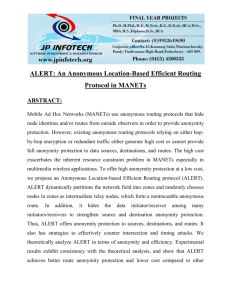

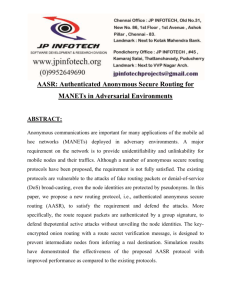
![Internetworking Technologies [Opens in New Window]](http://s3.studylib.net/store/data/007474950_1-04ba8ede092e0c026d6f82bb0c5b9cb6-300x300.png)
